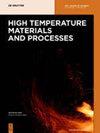用含硫固化剂评价邻苯二腈的热学性能和活化能
IF 1.6
4区 材料科学
Q4 MATERIALS SCIENCE, MULTIDISCIPLINARY
引用次数: 0
摘要
摘要本文采用Kissinger方程计算邻苯二腈的活化能,观察其热性能。我们通过合成邻苯二腈样品开始了我们的研究,加入了含硫固化剂,范围从2到10%。能量色散x射线光谱证实了固化工艺的成功。随后,我们使用热重分析(TGA)获得了输入基辛格方程所需的数据集。TGA结果表明固化剂的浓度与样品的热稳定性有直接关系。具体来说,用2%含硫固化剂处理的样品表现出中等的热稳定性(Td5%: 527.11°C)。然而,当固化剂浓度较高(即5%和10%)时,样品的Td5%值分别增加了532.75和540.01℃。热降解起始温度的增加表明,由于固化剂浓度的增加,交联密度和机械性能得到了提高。在Kissinger方程中,固化剂用量为2、5和10%时,活化能分别为43.6222、46.1365和67.9515 kcal·mol−1,R²值为0.9650 ~ 0.9701。本文章由计算机程序翻译,如有差异,请以英文原文为准。
Evaluating thermal properties and activation energy of phthalonitrile using sulfur-containing curing agents
Abstract This work used the Kissinger equation to compute the activation energy of phthalonitrile to observe thermal properties. We initiated our investigation by synthesizing phthalonitrile samples, incorporating sulfur-containing curing agents ranging from 2 to 10%. Energy-dispersive X-ray spectroscopy confirmed the success of the curing process. Subsequently, we used thermogravimetric analysis (TGA) to acquire the necessary dataset for input into the Kissinger equation. The TGA results pointed to a direct relationship between the concentration of the curing agent and the thermal stability of the samples. Specifically, a sample treated with a 2% sulfur-containing curing agent demonstrated a moderate thermal stability (Td5%: 527.11°C). However, samples treated with higher concentrations of the curing agent, namely, 5 and 10%, exhibited increased Td5% values of 532.75 and 540.01°C, respectively. The increased thermal degradation-onset temperatures suggest a boost in the cross-linking density and mechanical properties, a result of the increased curing agent concentration. Further substantiating these findings, the Kissinger equation yielded high activation energies of 43.6222, 46.1365, and 67.9515 kcal·mol −1 for the 2, 5, and 10% curing agent dosages, respectively, with R ² values ranging from 0.9650 to 0.9701.
求助全文
通过发布文献求助,成功后即可免费获取论文全文。
去求助
来源期刊

High Temperature Materials and Processes
工程技术-材料科学:综合
CiteScore
2.50
自引率
0.00%
发文量
42
审稿时长
3.9 months
期刊介绍:
High Temperature Materials and Processes offers an international publication forum for new ideas, insights and results related to high-temperature materials and processes in science and technology. The journal publishes original research papers and short communications addressing topics at the forefront of high-temperature materials research including processing of various materials at high temperatures. Occasionally, reviews of a specific topic are included. The journal also publishes special issues featuring ongoing research programs as well as symposia of high-temperature materials and processes, and other related research activities.
Emphasis is placed on the multi-disciplinary nature of high-temperature materials and processes for various materials in a variety of states. Such a nature of the journal will help readers who wish to become acquainted with related subjects by obtaining information of various aspects of high-temperature materials research. The increasing spread of information on these subjects will also help to shed light on relevant topics of high-temperature materials and processes outside of readers’ own core specialties.
 求助内容:
求助内容: 应助结果提醒方式:
应助结果提醒方式:


